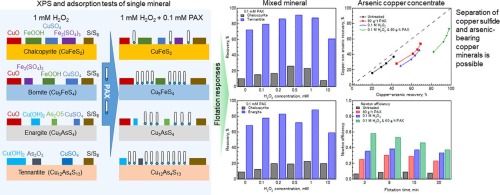当前位置:
X-MOL 学术
›
Miner. Eng.
›
论文详情
Our official English website, www.x-mol.net, welcomes your
feedback! (Note: you will need to create a separate account there.)
Effect of H2O2 and potassium amyl xanthate on separation of enargite and tennantite from chalcopyrite and bornite using flotation
Minerals Engineering ( IF 4.9 ) Pub Date : 2020-06-01 , DOI: 10.1016/j.mineng.2020.106371 Gde Pandhe Wisnu Suyantara , Tsuyoshi Hirajima , Hajime Miki , Keiko Sasaki , Shigeto Kuroiwa , Yuji Aoki
Minerals Engineering ( IF 4.9 ) Pub Date : 2020-06-01 , DOI: 10.1016/j.mineng.2020.106371 Gde Pandhe Wisnu Suyantara , Tsuyoshi Hirajima , Hajime Miki , Keiko Sasaki , Shigeto Kuroiwa , Yuji Aoki

|
Abstract Effect of oxidation treatment using hydrogen peroxide (H2O2) on the floatability of copper sulfide minerals (i.e., chalcopyrite and bornite) and arsenic-bearing copper minerals (i.e., tennantite and enargite) is reported in this study. Pure mineral flotation shows that the floatability of each mineral significantly decreases after the oxidation treatment. Interestingly, flotation of mixed mineral of copper sulfide and arsenic-bearing copper minerals shows that enargite and tennantite exhibit a higher floatability compared to chalcopyrite and bornite after the oxidation treatment followed by the addition of potassium amyl xanthate (PAX). These flotation results indicate a possibility for selective flotation of copper sulfide and arsenic-bearing copper minerals. Indeed, bench-scale flotation tests show that the oxidation treatment using H2O2 and the addition of PAX can deliver a satisfying separation of copper sulfide and arsenic-bearing copper minerals. Difference oxidation products (i.e., CuO, Cu(OH)2, CuSO4, FeOOH, and Fe2(SO4)3) on each mineral surface are likely the cause of this different flotation behavior. Furthermore, these oxidation products may affect the adsorption amount of PAX on each mineral. Indeed, the adsorption tests show that PAX is adsorbed more on tennantite, bornite, and enargite compared to chalcopyrite owing to the formation of CuSO4 and Cu(OH)2 on the mineral surfaces under oxidizing conditions. A possible mechanism is proposed in this study to explain the selective flotation behavior of mixed minerals.
中文翻译:

H2O2和戊基黄原酸钾对黄铜矿和斑铜矿浮选分离磷灰石和斑铜矿的影响
摘要 本研究报告了使用过氧化氢 (H2O2) 进行氧化处理对硫化铜矿物(即黄铜矿和斑铜矿)和含砷铜矿物(即钛白云母和磷灰石)的可浮性的影响。纯矿物浮选表明,氧化处理后各矿物的可浮性明显下降。有趣的是,硫化铜和含砷铜矿物的混合矿物的浮选表明,与黄铜矿和斑铜矿相比,在氧化处理后添加戊基黄原酸钾 (PAX) 后,enargite 和 Tennantite 表现出更高的可浮性。这些浮选结果表明选择性浮选硫化铜和含砷铜矿物的可能性。确实,小规模浮选试验表明,使用 H2O2 氧化处理和添加 PAX 可以提供令人满意的硫化铜和含砷铜矿物的分离。每种矿物表面上不同的氧化产物(即 CuO、Cu(OH)2、CuSO4、FeOOH 和 Fe2(SO4)3)可能是造成这种不同浮选行为的原因。此外,这些氧化产物可能会影响 PAX 在每种矿物上的吸附量。事实上,吸附试验表明,由于在氧化条件下在矿物表面形成 CuSO4 和 Cu(OH)2,与黄铜矿相比,PAX 在 Tennantite、斑铜矿和 enargite 上的吸附更多。本研究提出了一种可能的机制来解释混合矿物的选择性浮选行为。
更新日期:2020-06-01
中文翻译:

H2O2和戊基黄原酸钾对黄铜矿和斑铜矿浮选分离磷灰石和斑铜矿的影响
摘要 本研究报告了使用过氧化氢 (H2O2) 进行氧化处理对硫化铜矿物(即黄铜矿和斑铜矿)和含砷铜矿物(即钛白云母和磷灰石)的可浮性的影响。纯矿物浮选表明,氧化处理后各矿物的可浮性明显下降。有趣的是,硫化铜和含砷铜矿物的混合矿物的浮选表明,与黄铜矿和斑铜矿相比,在氧化处理后添加戊基黄原酸钾 (PAX) 后,enargite 和 Tennantite 表现出更高的可浮性。这些浮选结果表明选择性浮选硫化铜和含砷铜矿物的可能性。确实,小规模浮选试验表明,使用 H2O2 氧化处理和添加 PAX 可以提供令人满意的硫化铜和含砷铜矿物的分离。每种矿物表面上不同的氧化产物(即 CuO、Cu(OH)2、CuSO4、FeOOH 和 Fe2(SO4)3)可能是造成这种不同浮选行为的原因。此外,这些氧化产物可能会影响 PAX 在每种矿物上的吸附量。事实上,吸附试验表明,由于在氧化条件下在矿物表面形成 CuSO4 和 Cu(OH)2,与黄铜矿相比,PAX 在 Tennantite、斑铜矿和 enargite 上的吸附更多。本研究提出了一种可能的机制来解释混合矿物的选择性浮选行为。









































 京公网安备 11010802027423号
京公网安备 11010802027423号